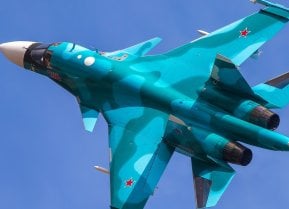Able Archer: How NATO vs. Russia Nuclear World War III Almost Started?
Though the Soviets had observed past NATO drills, Able Archer 83 featured several new elements to confuse and disorient the Soviets. In some ways, it may have worked too well.
Forty Years Ago World War III Almost Started Due to a Training Exercise - Four decades ago this past November, World War III almost started – at least it did according to some claims. Yet, it wasn't because of saber-rattling on the part of the Soviet Union, although the Kremlin was involved in its ongoing conflict in Afghanistan. Rather, a NATO training drill that began on November 7, 1983, was misinterpreted by Moscow – which believed that the Able Archer 83 command-post exercise simulating nuclear war with the Warsaw Pact was in fact a preparation for an attack.
The drill had been an annual occurrence for years, but that year the Kremlin's reaction was "unprecedented," and some scholars have suggested it was one of the times when the world came the closest to Armageddon since the Cuban Missile Crisis in 1962.
It is important to remember that just two years before the exercise, then-President Ronald Reagan took a much more aggressive stance against the Soviet Union. In addition to increased military spending, the White House embarked on the development of a missile defense system (the Strategic Defense Initiative) and at the same time announced a plan to deploy new intermediate-range nuclear missiles – including Pershing II and ground-launched cruise missiles – in Europe. The Pershing II was particularly concerning to the Kremlin as they could strike targets deep in the Soviet Union within minutes, potentially eliminating Moscow's ability to retaliate in the event of a sneak attack.
Able Archer - Did the Soviets Overreact?
Though the Soviets had observed past NATO drills, Able Archer 83 featured several new elements that were meant to confuse and disorient the Soviets. In some ways, it may have worked too well.
During Able Archer 83, NATO forces simulated a move through all alert phases, from DEFCON 5 to DEFCON 1. While these phases were simulated, alarmist KGB agents may have mistakenly reported them as real.
According to ArmsControlCenter.org, "KGB observers alerted Moscow of the unusual activity, and paranoia set in. Working off dubious intelligence that a NATO offensive against the U.S.S.R. could be cloaked under the guise of a military exercise, the Soviets began preparations for a large-scale retaliation. Then Soviet leader Yuri Andropov mobilized entire military divisions, transported nuclear weapons to their launch sites, and scrambled a fleet of bombers carrying nuclear warheads. Military command handed Andropov the nuclear briefcase, known in Russia as the 'cheget.'"
Soviet nuclear capabilities were prepared and dispersed – and Western intelligence quickly picked on some of the maneuvers. This reportedly included aircraft in Poland and East Germany that were loaded with nuclear bombs, 70 SS-20 intermediate-range ballistic missiles (IRBMs) launchers were put on high alert, and Soviet nuclear submarines were sent under the Arctic ice, where they would be undetected by American radar and sonar systems.
Fortunately, U.S. military leaders opted not to mirror the Soviet alert. U.S. Lieutenant General Leonard H. Perroots was among those who advised against responding to the Warsaw Pact military activity
Able Archer 83 concluded on November 11, and the world continued as if nothing happened.
Were We Really Close to World War III?
Few in the West initially knew how close we may have come to a nuclear war, yet, it was only a week later that the Soviet Minister of Defense warned in a major Soviet newspaper that NATO's military exercises were "becoming increasingly difficult to distinguish from a real deployment of armed forces for aggression."
The exercise only attracted widespread public attention in 2015 when the President's Intelligence Advisory Board 1990 report on the exercise was declassified. It likely came as a surprise that some 32 years earlier a nuclear war almost began.
Yet, even with four decades of hindsight, the riddle that is an enigma within Moscow hasn't truly been solved.
As the Bulletin of The Atomic Scientists questioned, "Did Soviet officials see Able Archer 83 as a possible subterfuge for a real attack? Or was the Soviet reaction a propaganda move or psy-op geared toward influencing Western policies?"
The Bulletin further suggested that "While the claim that the Soviet Union was about to launch a “preemptive” attack lacks empirical support, it is too soon to conclude definitively that the event carried no risk of escalation. That we still do not know, four decades later, how close the Able Archer exercise brought the world to nuclear war highlights the uncertainty that defines nuclear policy making."
In other words, did the Soviets want the West to believe it believed a war was brewing? Perhaps we'll never fully know the answer. The question is how many other times were we close to the end of the world?
Author Experience and Expertise
Peter Suciu is a Michigan-based writer. He has contributed to more than four dozen magazines, newspapers, and websites with over 3,200 published pieces over a twenty-year career in journalism. He regularly writes about military hardware, firearms history, cybersecurity, politics, and international affairs. Peter is also a Contributing Writer for Forbes and Clearance Jobs. You can follow him on Twitter: @PeterSuciu.


